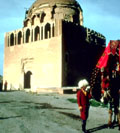 "Genghis Khan's hordes couldn't wipe out the great city at Merv even as they killed hundreds of thousands in their bloody wave of conquest. Centuries later, though, modern man's meddling with nature threatens to obliterate the once magnificent metropolis. "
"Genghis Khan's hordes couldn't wipe out the great city at Merv even as they killed hundreds of thousands in their bloody wave of conquest. Centuries later, though, modern man's meddling with nature threatens to obliterate the once magnificent metropolis. "
Merv is unique because ruins dating to the 6th century B.C. to the 18th century A.D. from the five settlements once located here sit side by side, scattered across 1,500 hectares (3,700 acres), rather than stacked on top of each other.
The city's golden age was in the 11th and 12th centuries, when the Sultan Kala fortress was the eastern capital of the Turkish Seljuk Empire and one of the world's biggest cities. As legend goes, the blue dome of the Sultan Sanjar mausoleum was visible a day's journey away.
That era ended when Mongolian warriors led by Genghis Khan's son sacked the city in 1221. A 13th-century historian put the body count after their rampage at 1.3 million.
Today, in at least two of the key remaining buildings at the site _ fortresses known as the Great Kyz Kala and Little Kyz Kala dating from the 6th or 7th centuries A.D. -- walls are beginning to lean and are at risk of toppling.
See also: Merv Threatened
No comments:
Post a Comment